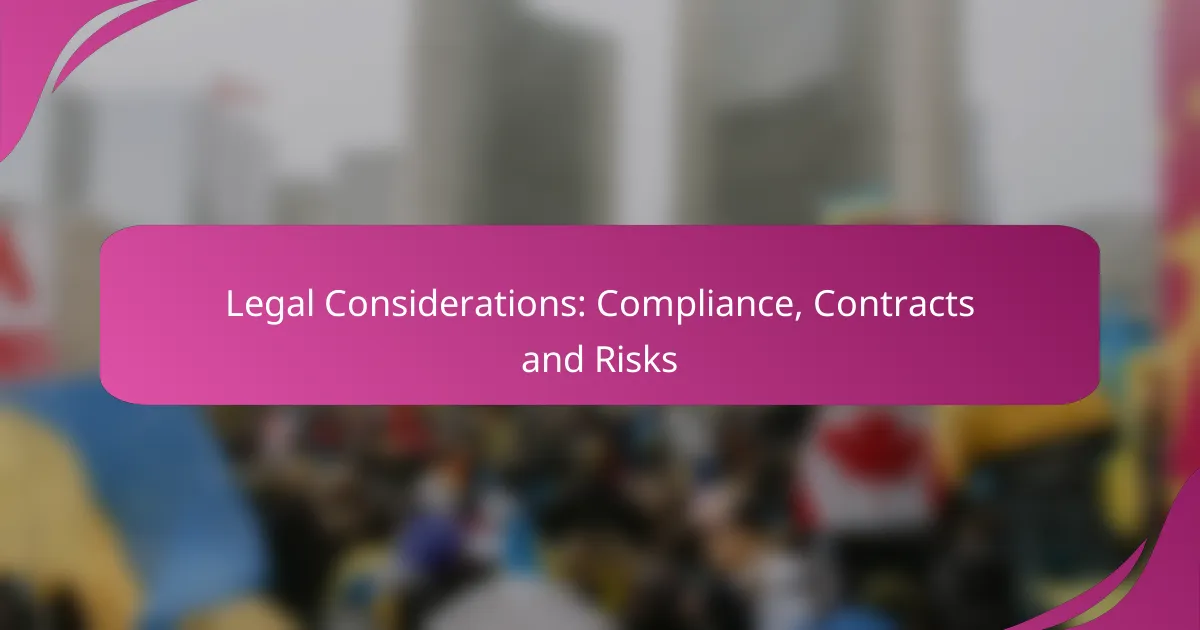Understanding legal considerations is essential for any organization aiming to operate within the bounds of the law. Compliance with regulations and standards is critical, as it influences various aspects of business operations, including data management and employment practices. Additionally, effective contract drafting ensures clarity and mutual understanding, which helps mitigate disputes and legal risks that could jeopardize a company’s financial health and reputation.

What Are the Key Legal Compliance Requirements?
Key legal compliance requirements encompass a range of regulations and standards that organizations must adhere to in order to operate legally and ethically. These requirements vary by industry and jurisdiction, influencing how businesses manage data, employment practices, environmental impact, and safety protocols.
Data Protection Regulations
Data protection regulations are designed to safeguard personal information and ensure privacy. In the European Union, the General Data Protection Regulation (GDPR) mandates strict guidelines on data collection, processing, and storage, imposing heavy fines for non-compliance. Businesses should implement robust data management practices, including obtaining consent and ensuring data security.
In the United States, regulations like the California Consumer Privacy Act (CCPA) provide similar protections but vary by state. Companies should regularly review their data handling processes to align with applicable laws and avoid potential legal pitfalls.
Employment Law Compliance
Employment law compliance involves adhering to regulations governing workplace practices, including hiring, wages, and employee rights. In many countries, laws require fair treatment, non-discrimination, and safe working conditions. Organizations should familiarize themselves with local labor laws to ensure compliance and mitigate risks related to employee grievances.
Regular training and clear policies can help prevent violations. Businesses should also maintain accurate records of employee hours and wages to comply with wage-and-hour laws.
Environmental Regulations
Environmental regulations aim to protect natural resources and public health by controlling pollution and waste management. Companies must comply with local, national, and international environmental laws, which often require permits for emissions and waste disposal. Understanding the specific regulations that apply to your industry is crucial for compliance.
Regular environmental audits can help identify areas for improvement and ensure adherence to regulations. Companies should also consider adopting sustainable practices to reduce their environmental impact and enhance their reputation.
Industry-Specific Standards
Industry-specific standards set benchmarks for quality, safety, and performance within particular sectors. For example, the ISO 9001 standard focuses on quality management systems, while the ISO 14001 standard addresses environmental management. Compliance with these standards can enhance operational efficiency and customer satisfaction.
Organizations should evaluate which standards apply to their industry and invest in training and certification to demonstrate compliance. This can lead to improved credibility and competitive advantage.
Health and Safety Laws
Health and safety laws are designed to protect employees from workplace hazards. Regulations often require employers to implement safety protocols, conduct regular risk assessments, and provide training. Compliance with these laws is essential to prevent accidents and legal liabilities.
Employers should establish a health and safety policy, conduct regular training sessions, and encourage reporting of unsafe conditions. Regular inspections and audits can help maintain compliance and foster a safe working environment.

How to Draft Effective Contracts?
To draft effective contracts, focus on clarity, specificity, and mutual understanding between parties. A well-structured contract outlines the rights and obligations of each party, reducing the risk of disputes and ensuring compliance with applicable laws.
Essential Contract Elements
Key elements of a contract include offer, acceptance, consideration, and mutual intent to create a legal obligation. Each party must clearly understand their responsibilities and the terms of the agreement. Additionally, identifying the parties involved and specifying the subject matter is crucial for clarity.
Consider including a termination clause, which outlines the conditions under which the contract can be ended. This helps manage expectations and provides a clear exit strategy for both parties.
Common Contract Clauses
Common clauses in contracts include confidentiality, indemnification, and dispute resolution. A confidentiality clause protects sensitive information from being disclosed, while indemnification clauses allocate risk by specifying who is responsible for damages or losses.
Dispute resolution clauses outline how conflicts will be handled, whether through mediation, arbitration, or litigation. Including these clauses can save time and costs associated with legal disputes.
Negotiation Strategies
Effective negotiation strategies involve preparation, active listening, and flexibility. Before entering negotiations, identify your objectives and understand the other party’s needs. This helps create a win-win situation.
During negotiations, maintain open communication and be willing to adjust your position based on the discussion. Use clear language and avoid jargon to ensure both parties understand the terms being negotiated.
Contract Review Best Practices
Reviewing contracts thoroughly is essential to avoid potential pitfalls. Start by checking for clarity and consistency in terms, ensuring that all essential elements are present. Look for ambiguous language that could lead to misunderstandings.
Consider involving legal professionals for complex contracts, especially those involving significant financial commitments or regulatory compliance. A second pair of eyes can help identify risks and ensure that the contract aligns with legal standards.

What Are the Risks of Non-Compliance?
Non-compliance can lead to significant risks that affect a business’s financial health, legal standing, reputation, and operational efficiency. Understanding these risks is crucial for any organization to mitigate potential damage and ensure adherence to relevant laws and regulations.
Financial Penalties
Financial penalties for non-compliance can vary widely depending on the nature of the violation and the governing laws. Businesses may face fines ranging from hundreds to millions of dollars, depending on the severity and frequency of the infractions. For example, data protection violations under GDPR can result in fines up to 4% of annual global revenue.
To avoid these penalties, organizations should regularly audit their compliance practices and ensure they are up to date with current regulations. Investing in compliance training for employees can also help reduce the risk of costly mistakes.
Legal Liabilities
Legal liabilities arise when a business fails to comply with laws, leading to lawsuits or regulatory actions. This can result in costly legal fees and settlements, as well as potential criminal charges for individuals involved. For instance, violations of labor laws can lead to lawsuits from employees seeking damages.
To minimize legal liabilities, companies should implement robust compliance programs and consult legal experts when drafting contracts or policies. Regular training and clear communication of legal obligations to employees are also essential.
Reputational Damage
Reputational damage from non-compliance can have long-lasting effects on a business’s brand and customer trust. Negative publicity from compliance failures can lead to a decline in customer loyalty and loss of market share. For example, companies involved in data breaches often face severe backlash from consumers.
To protect their reputation, businesses should prioritize transparency and proactive communication with stakeholders. Establishing a strong ethical culture and demonstrating commitment to compliance can help rebuild trust if issues arise.
Operational Disruptions
Operational disruptions can occur when compliance failures lead to investigations or regulatory actions, impacting business continuity. These disruptions can result in halted operations, loss of productivity, and increased costs. For example, a company under investigation may need to divert resources to address compliance issues instead of focusing on core business activities.
To mitigate operational disruptions, organizations should develop contingency plans and ensure compliance processes are integrated into daily operations. Regular training and clear protocols can help employees understand their roles in maintaining compliance and minimizing disruptions.

How to Mitigate Legal Risks?
To mitigate legal risks, organizations should implement a proactive approach that includes thorough risk assessments, compliance training, and appropriate insurance coverage. These strategies help identify potential legal issues and ensure adherence to relevant laws and regulations.
Risk Assessment Procedures
Risk assessment procedures involve identifying, analyzing, and evaluating potential legal risks that could impact an organization. This process typically includes reviewing contracts, operational practices, and regulatory compliance to pinpoint vulnerabilities.
Organizations should conduct regular risk assessments, ideally on an annual basis or whenever significant changes occur. Utilizing tools like risk matrices can help prioritize risks based on their likelihood and potential impact, allowing for focused mitigation efforts.
Compliance Training Programs
Compliance training programs are essential for educating employees about legal obligations and company policies. These programs should cover relevant laws, such as labor regulations, data protection laws, and industry-specific compliance requirements.
Effective training should be interactive and ongoing, with refresher courses offered at least annually. Incorporating real-world scenarios and case studies can enhance understanding and retention, helping employees recognize and avoid potential legal pitfalls.
Insurance Options
Insurance options play a crucial role in mitigating legal risks by providing financial protection against potential claims. Common types of insurance include general liability, professional liability, and directors and officers (D&O) insurance, each addressing different aspects of legal exposure.
When selecting insurance, organizations should assess their specific risks and consider coverage limits that align with their operations. Consulting with an insurance broker can help identify the most suitable policies and ensure adequate protection against legal liabilities.
